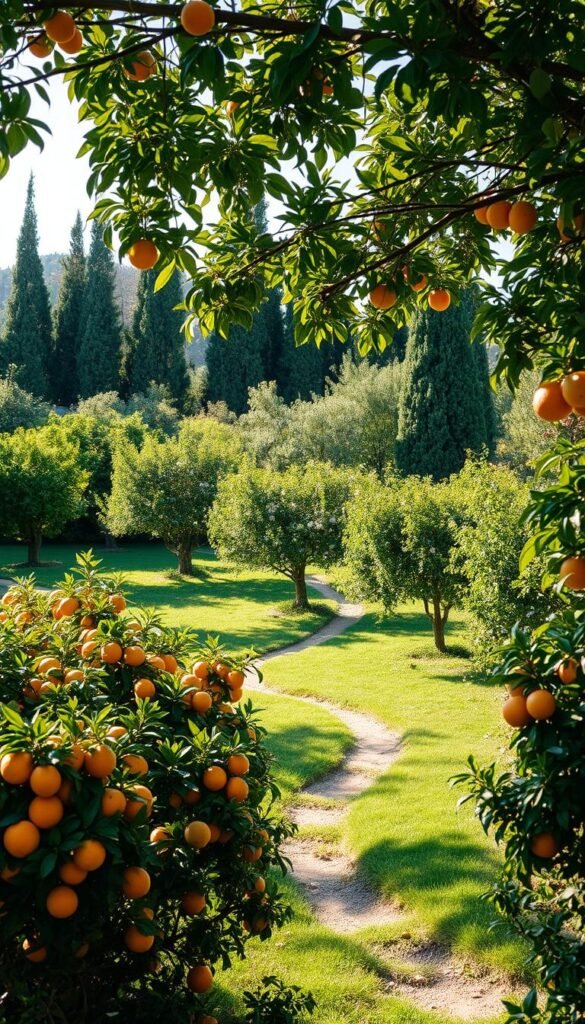Transforming your outdoor space into a lush, productive retreat starts with smart planning. Imagine stepping outside to pluck ripe, sun-warmed treats straight from your own yard—all while creating a habitat for birds and pollinators. Strategic placement of edible plants blends beauty with purpose, turning even modest areas into thriving ecosystems.
Success hinges on understanding how sunlight patterns and spacing affect your plants’ health. Most varieties need at least five years to establish strong roots before yielding substantial harvests. This patience pays off with decades of bounty, making early planning critical for long-term rewards.
Compact yards can flourish with dwarf species or vertical growing techniques. Thoughtful layout choices ensure each plant gets adequate airflow and nutrients without overcrowding. You’ll create visual interest through seasonal blooms and foliage while supporting local biodiversity.
Your edible landscape becomes a living investment that evolves yearly. With proper care, these plantings reduce your environmental footprint while providing fresh, organic snacks. Ready to craft a space that nourishes both your family and the planet? Let’s explore how to make it thrive.
Understanding the Benefits of a Fruit Tree Garden
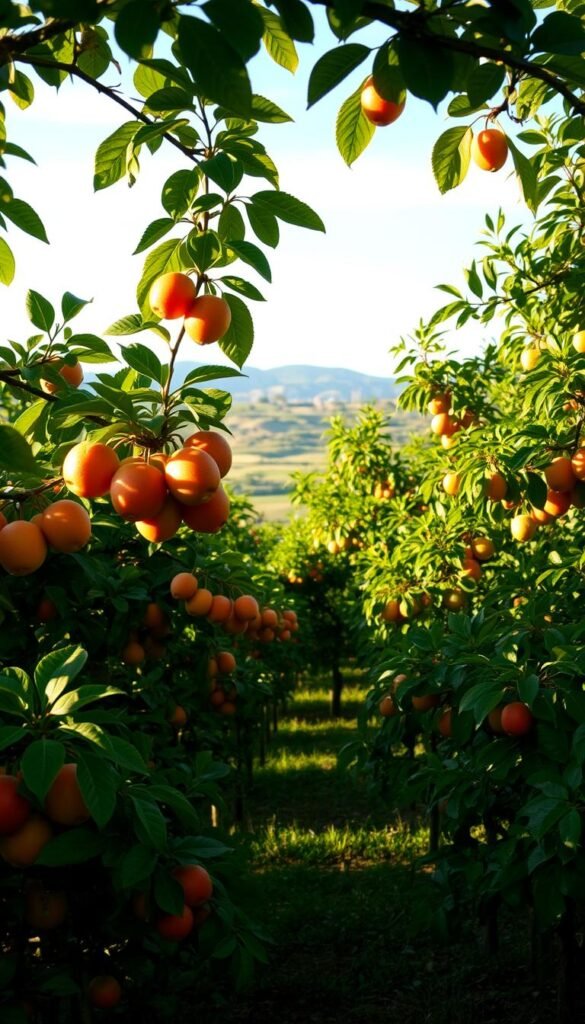
Your backyard holds untapped potential beyond basic landscaping—it can become a vibrant hub of flavor and life. Edible plantings offer dynamic beauty through shifting seasons while serving practical purposes. Let’s unpack how these living investments elevate your space in surprising ways.
Aesthetic and Environmental Advantages
Imagine branches bursting with pink blossoms in spring, followed by lush greenery and ripe treats. These natural showstoppers create focal points that evolve monthly. Their canopies filter air pollutants, making every breath cleaner for your household.
Birds and pollinators flock to flowering varieties, turning your yard into a wildlife sanctuary. One homeowner shared, “Our apple blossoms attract more hummingbirds than any feeder ever did!” This biodiversity strengthens your local ecosystem naturally.
Economic and Personal Rewards
Growing your snacks slashes grocery bills—a single dwarf citrus can yield 40+ pounds annually. You’ll savor flavors no store can match, like sun-warmed berries that explode with sweetness. Kids gain hands-on nutrition lessons when plucking snacks straight from the source.
Every harvest reduces plastic waste from supermarket packaging. Over time, your plantings become legacy features that outlive typical landscape elements. The pride of sharing homegrown peaches with neighbors? That’s a reward no price tag can capture.
Assessing Your Backyard for Optimal Light, Soil, and Space
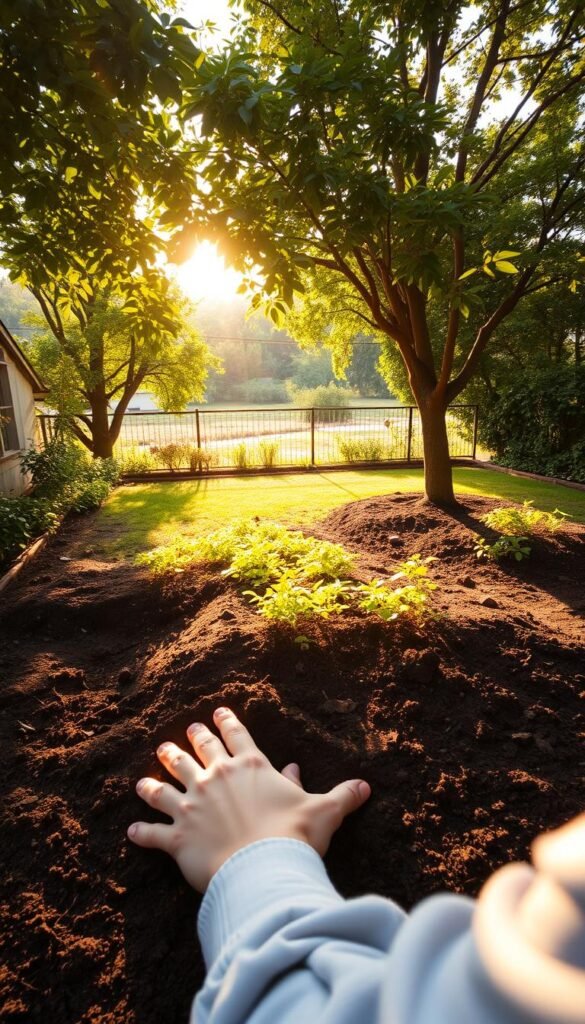
Mapping your yard’s potential begins with three key factors: light exposure, ground composition, and available room. These elements determine which plants will flourish and where they’ll thrive best.
Evaluating Sunlight Patterns and Shade
Track how sunlight moves across your area through seasons. Full sun spots (6+ hours daily) suit most productive varieties, while partial shade areas work for figs or currants. Use free apps like Sun Seeker to create a digital “sun map” of your space.
Morning light helps dry dew, reducing disease risks. Afternoon shade protects delicate blooms in hotter regions. Observe patterns weekly—spring sun angles differ from summer’s peak intensity.
Soil Quality and Space Considerations
Test your ground’s pH and nutrients with a $10 kit from garden centers. Most edibles prefer slightly acidic soil conditions (6.0-7.0 pH). Amend clay-heavy earth with compost to improve drainage—a common issue in suburban yards.
Measure horizontal and vertical space for mature plant size. Dwarf varieties need 8-10ft between trunks, while standard types require 15-20ft. Remember: roots spread 2-3x wider than canopies! Leave room for walking paths and maintenance access.
Local climate dictates suitable species—check USDA zone maps. One gardener shared, “Switching to native persimmons tripled my harvests!” Pair this knowledge with your soil quality data to make smart picks.
Fruit Tree Garden Design for Backyards: Balancing Shade, Light, and Growth
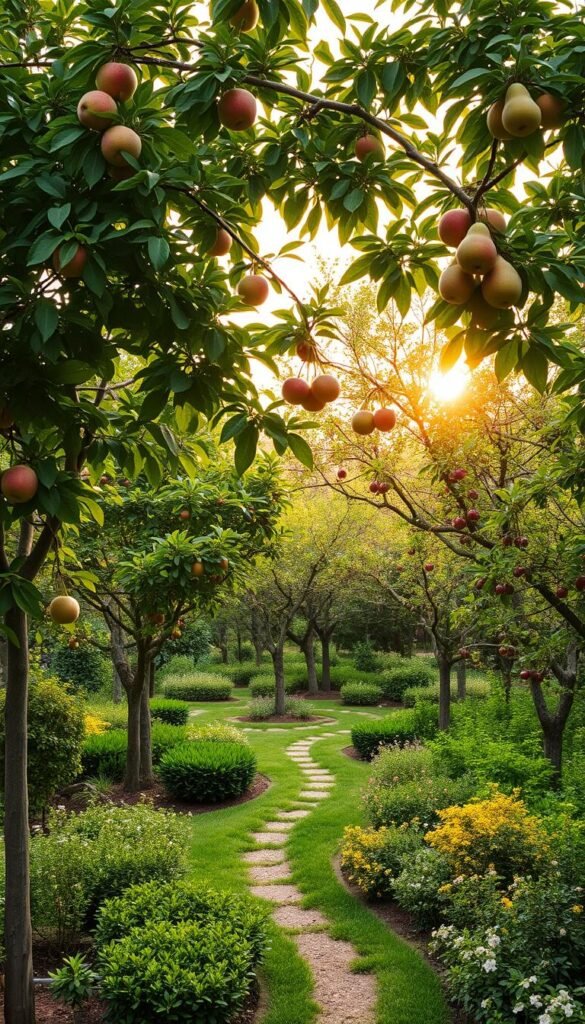
Crafting an edible landscape requires smart spatial strategies that marry form and function. Start by anchoring your space with a statement specimen—a mature apple or citrus variety makes a striking centerpiece. These larger specimens create visual hierarchy while establishing microclimates for surrounding plantings.
Frame walkways with compact cherry or plum varieties that stay under 8 feet tall. Their slender profiles define spaces without crowding, letting you reach branches easily during harvest. Pair them with lavender or rosemary for fragrant borders that deter pests naturally.
Mix edible and ornamental elements by underplanting with pollinator-friendly blooms. Marigolds and nasturtiums add pops of color while attracting beneficial insects. One gardener noted, “My peach yield doubled after adding bee balm around the trunk base!”
Vertical solutions unlock productivity in tight quarters. Train passionfruit vines on trellises or create strawberry towers from stacked planters. These space-saving techniques let you grow up to 3x more food in the same footprint.
Match varieties to your available room through smart pruning. Espaliered figs against sunny walls or columnar apples in narrow beds maintain airflow and light penetration. Regular trimming shapes growth patterns while encouraging heavier fruiting.
Planting Techniques and Early Care for Fruit Trees
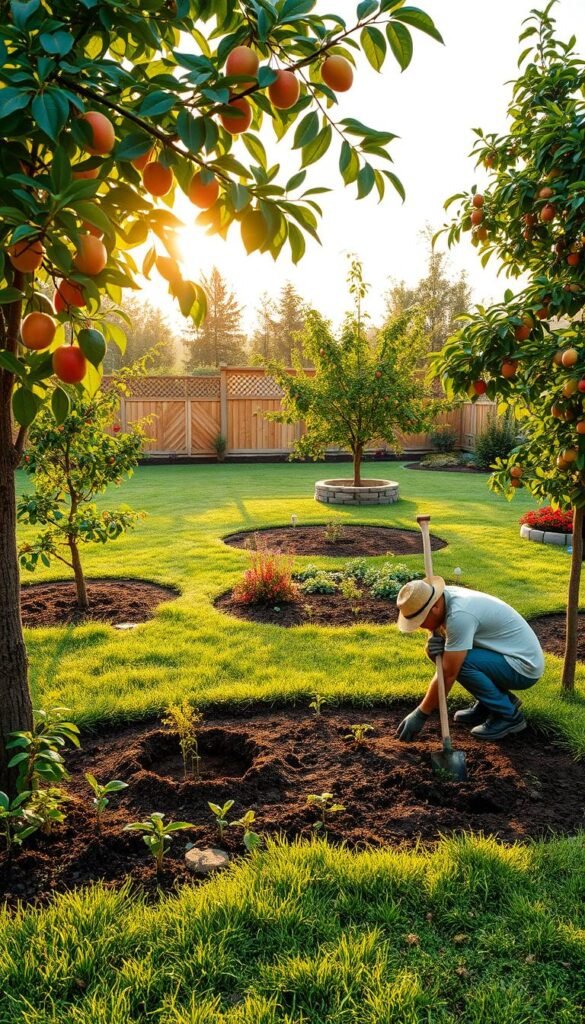
Setting up your edible landscape begins with smart planting strategies that ensure strong starts. Proper techniques during the first three years determine long-term health and productivity. Let’s break down the essentials for giving your new additions their best chance.
Site Preparation and Correct Planting Steps
Clear grass and weeds from a 4-foot diameter area. Dig a hole twice as wide as the root ball but no deeper. Mix 30% compost with native soil for better nutrients and drainage.
Gently tease out circling roots before placing the plant. Position the root flare level with the ground. Backfill halfway, water thoroughly, then finish filling. This removes air pockets that dry out roots.
Watering, Mulching, and Fertilization Practices
New plantings need 5 gallons of water weekly during dry spells. Use a slow trickle to soak the root zone deeply. Apply 3 inches of mulch in a doughnut shape—never touching the trunk.
| Mulch Type | Benefits | Application |
|---|---|---|
| Wood chips | Retains moisture | 2-3″ layer |
| Straw | Breaks down quickly | Replace monthly |
| Compost | Adds nutrients | 1″ layer |
Pruning, Pest Control, and Initial Support
Trim broken branches immediately after planting. Wait until dormancy for major shaping cuts. Stake only if the trunk bends—remove supports after one year.
Check weekly for aphids or leaf curl. A gardener shared, “Neem oil spray stopped my pear tree infestations without chemicals.” Healthy plants resist pests better, so focus on proper watering and nutrients first.
Incorporating Innovative Space-Saving Designs
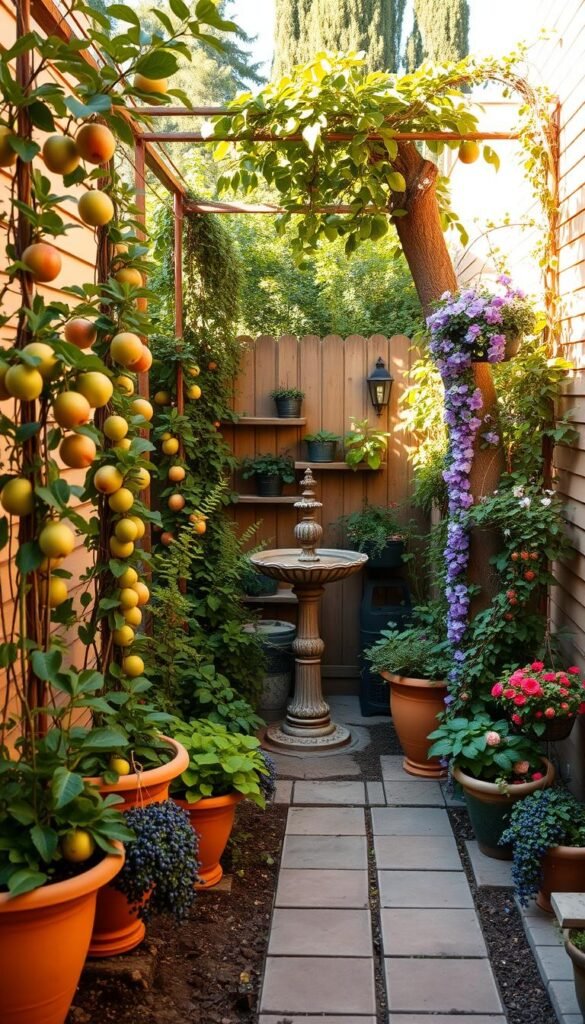
Small spaces become powerhouses of productivity with clever arrangement strategies. Pairing vertical elements with strategic plant partnerships lets you grow more in less room while boosting ecosystem health.
Vertical Gardening and Companion Planting Ideas
Train climbing berries or grapes on trellises to free up ground space. Underplant these vertical growers with pest-repelling herbs like basil and thyme. One gardener reported, “My raspberry yield tripled when I paired them with marigolds—fewer beetles, more berries!”
Creative Layouts for Compact Backyards
Cluster 3-4 dwarf varieties around a central compost tower—their roots feed from shared nutrients while staying compact. Multi-graft specimens let you harvest plums, apricots, and peaches from one trunk. These solutions turn tight corners into edible showcases.
| Technique | Space Saved | Best For |
|---|---|---|
| Vertical stacking | 65% | Vining plants |
| Companion pairs | 40% | Pest control |
| Multi-graft trees | 80% | Small families |
| Clustered planting | 50% | Urban lots |
| Layered systems | 75% | Berry lovers |
Mix blueberries as understory plants beneath columnar apples. This layered approach provides staggered harvests from spring through fall. Your patio becomes a living pantry without feeling cramped.
Maintaining Your Fruit Tree Garden Throughout the Seasons
Your edible oasis thrives through attentive care across nature’s cycles. Smart seasonal routines keep plants vigorous while maximizing their tasty rewards. Let’s explore how simple habits protect your investment and boost harvests.
Seasonal Maintenance Strategies
Late winter’s dormant phase offers the best time for shaping cuts. Remove crossed branches to improve airflow and sunlight penetration. A gardener shared, “My peach production doubled after switching to February pruning!”
Monitor soil moisture weekly during growth spurts. Use your finger to check the top 2 inches—water only when dry. Mulch replenishment in spring locks in hydration while suppressing weeds.
Optimizing Long-Term Growth and Yield
Young specimens need training to build structural integrity. Use soft ties to guide branches into open shapes that support heavy fruits. Annual compost applications feed roots without burning them.
Inspect leaves monthly for discoloration or pests. Early intervention prevents small issues from becoming crises. With patience, your yard becomes a legacy—healthy trees can outlive their caretakers, bearing sweetness for decades.

